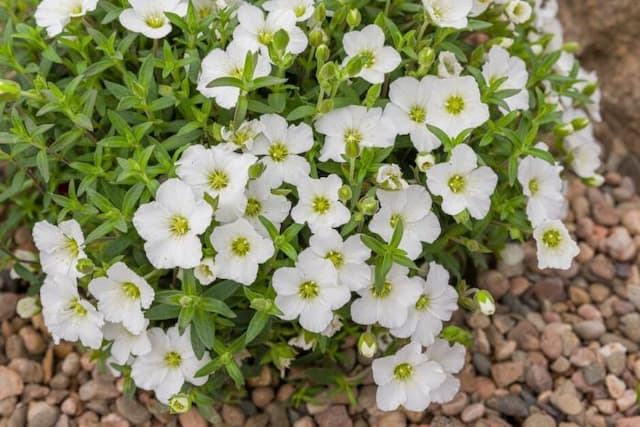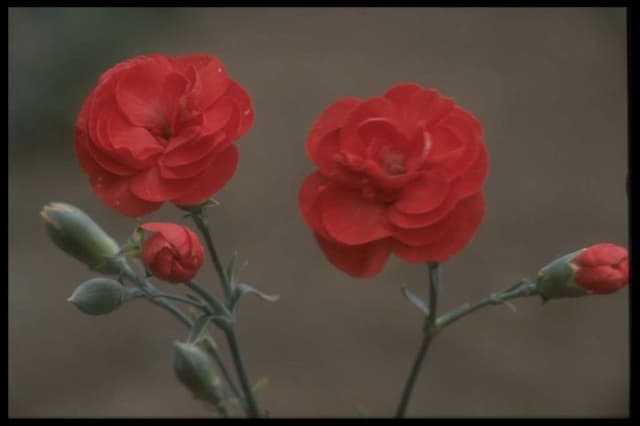Pink Dianthus 'Devon Kitty' (PBR) (p)

ABOUT
Dianthus 'Devon Kitty' is a delightful garden plant known for its charming and picturesque appearance. It boasts slender stems topped with a profusion of blooms. Each flower is intricately patterned, with petals showcasing a delightful blend of color that typically includes shades of pink, often with darker or lighter accents that can accentuate their frilled edges. The center of each blossom may display a contrasting hue, adding to the plant's visual appeal. The blooms come together in a clustered formation, providing a showy display that can catch the eye from a distance. The foliage of this plant is equally attractive, composed of slender, linear leaves that offer a backdrop of greenery to complement the vibrant flowers. The leaves have a blue-green to gray-green color, which is typical for this kind of plant, adding a cooling effect to the landscape. The overall form of the Dianthus 'Devon Kitty' is compact and neat, with a lush, mounded habit that contributes to its ornamental value. The texture of both the petals and the foliage is fine, hence the plant lends a delicate and soft aesthetic to gardens. When in full bloom, this plant can serve as a focal point in garden beds, borders, or containers, thanks to its striking flowers and pleasant foliage. Furthermore, these blooms may produce a sweet fragrance that can be particularly enjoyable on warm days or in the evenings, creating an inviting sensory experience in any garden space. Whether planted individually or grouped with other garden plants, Dianthus 'Devon Kitty' offers an element of charm to any outdoor space.
About this plant
 Names
NamesSynonyms
Devon Kitty Pink, Cheddar Pink, Carnation, Sweet William
Common names
Dianthus 'Devon Kitty'
 Toxicity
ToxicityTo humans
Dianthus, commonly known as "pinks", isn't typically known for being poisonous to humans. There's limited information on the specific cultivar 'Devon Kitty', but members of the Dianthus genus are generally considered to be non-toxic. Ingesting parts of the plant is not expected to cause more than mild gastrointestinal upset, if any symptoms occur at all. It's still advised to avoid consuming non-food plant parts due to possible individual sensitivities.
To pets
Dianthus, or "pinks", is not listed as toxic to pets by major animal poison control resources. It is generally considered safe for cats and dogs. If a pet were to ingest parts of a Dianthus 'Devon Kitty' plant, it is unlikely to experience more than mild gastrointestinal discomfort, if any symptoms arise. As with humans, the ingestion of non-food plants should still be discouraged to prevent potential individual adverse reactions.
 Characteristics
CharacteristicsLife cycle
Perennials
Foliage type
Evergreen
Color of leaves
Green
Flower color
Pink
Height
1 foot (30 cm)
Spread
1 foot (30 cm)
Plant type
Herb
Hardiness zones
5
Native area
Europe
Benefits
 General Benefits
General Benefits- Easy to grow: Dianthus 'Devon Kitty' is known for being easy to care for and requiring minimal maintenance, making it ideal for novice gardeners.
- Aesthetic appeal: With its beautiful pink flowers and compact growth habit, this plant adds color and charm to any garden or container.
- Drought-tolerant: Once established, this plant can withstand periods of dry weather, reducing the need for frequent watering.
- Long blooming season: It typically has a lengthy flowering period, providing vibrant blossoms throughout the growing season.
- Attracts pollinators: The flowers attract bees and butterflies, which is beneficial for pollination in the garden.
- Low fertilizer needs: Dianthus 'Devon Kitty' doesn't require a lot of fertilizer, which makes it easier to manage and more cost-effective for gardeners.
- Deer resistant: It is known to be resistant to deer, which is great for gardeners in areas where deer predation is a problem.
- Compact size: Its small size makes it suitable for growing in containers, rockeries, or the front of garden borders without taking too much space.
- Cold hardy: This variety of dianthus is able to withstand colder temperatures, making it suitable for a variety of climates.
- Versatility: The plant can be used for various landscape designs, including edging, mass planting, and as a ground cover.
 Medical Properties
Medical PropertiesThis plant is not used for medical purposes.
 Air-purifying Qualities
Air-purifying QualitiesThis plant is not specifically known for air purifying qualities.
 Other Uses
Other Uses- Natural Fabric Dye: The petals of the Dianthus plant can be used to create a natural dye for fabrics, producing a variety of soft pink to vibrant red hues, depending on the mordant used.
- Edible Garnishing: Dianthus 'Devon Kitty' petals are edible and can be used to add a splash of color and a subtle spicy flavor to salads and desserts.
- Botanical Art: The bright and colorful petals of Dianthus can be used in pressed flower projects for creating bookmarks, cards, or decorative frames.
- Culinary Oil Flavoring: Petals can be infused in oils to create floral flavored oils that add unique taste to dishes, especially desserts and baked goods.
- Plant Potpourri: Dried petals of Dianthus 'Devon Kitty' can be added to potpourri mixes for a natural and fragrant home scent.
- Flower Confetti: Dried or fresh petals can serve as a biodegradable substitute for traditional confetti at weddings or celebrations.
- Floral Bath Soaks: Petals can be mixed into bath salts to provide a luxurious and aromatic bathing experience.
- Signature Cocktails: Fresh Dianthus petals can be used to adorn cocktails, providing an elegant touch and mild flavor enhancement.
- Photography Subjects: Due to their vibrant colors and intricate patterns, Dianthus 'Devon Kitty' flowers make excellent subjects for macro photography projects.
- Floral Ice Cubes: Freeze petals in ice cubes for a decorative touch in cold drinks, adding beauty to summer beverages and special events.
Interesting Facts
 Feng Shui
Feng ShuiThe plant Pink is not used in Feng Shui practice.
 Zodiac Sign Compitability
Zodiac Sign CompitabilityThe plant Pink is not used in astrology practice.
 Plant Symbolism
Plant Symbolism- Love: The Dianthus genus is commonly known as "pinks" and traditionally symbolizes love and affection.
- Pure Affection: Dianthus 'Devon Kitty', with its delicate and dainty flowers, is seen as a gesture of pure affection and platonic love.
- Boldness: The rich colors of the Dianthus blooms suggest courage and boldness, perhaps inspired by the historic use of their flowers in heraldry and classic symbolism.
- Devotion: Pinks are emblematic of devotion due to their long-lasting nature and the belief that they can endure with integrity.
- Fascination: The intricate patterns of the Dianthus 'Devon Kitty' often lead to it symbolizing fascination or admiration for complexity and detail.
 Water
WaterPink Kisses require moderate watering to ensure the soil stays moist but not waterlogged. Typically, watering once a week with approximately 16 ounces of water proves sufficient, but this may vary depending on climate and weather conditions. During hot, dry periods, more frequent watering may be necessary. Always check the top inch of the soil before watering; if it feels dry, it's time to water. In winter, reduce the frequency to account for slower growth and evaporation rates.
 Light
LightPink Kisses thrive best in full sun to partial shade conditions. To promote healthy growth and abundant flowering, place them in a spot where they will receive at least 6 hours of sunlight per day. However, in very hot climates, some afternoon shade can help protect the flowers from intense midday sun.
 Temperature
TemperaturePink Kisses prefer temperatures between 40 and 80 degrees Fahrenheit and can withstand temporary dips below freezing to about 20 degrees Fahrenheit. Ideal growth is seen within the 60 to 70 degrees Fahrenheit range; however, extreme temperatures beyond the tolerance range can harm or kill the plant.
 Pruning
PruningPrune Pink Kisses regularly to encourage bushier growth and more blooms. Deadhead spent flowers during the blooming season to encourage new blossoms and cut back any leggy stems. The best time for heavier pruning is early spring before new growth begins.
 Cleaning
CleaningAs needed
 Soil
SoilThe best soil mix for the Pink 'Devon Kitty' should be well-draining, loamy or sandy with some organic matter. A perfect blend would be equal parts of potting soil, compost, and coarse sand or perlite. The soil pH should ideally range between 6.0 and 7.5 to ensure healthy growth and blooming.
 Repotting
RepottingPink 'Devon Kitty' typically does not require frequent repotting and can be done every 2-3 years. It's important to repot when the plant outgrows its current container or when the soil is depleted and compacted.
 Humidity & Misting
Humidity & MistingPink 'Devon Kitty' is tolerant of a range of humidity levels but prefers moderate conditions. It thrives in typical household humidity; however, ensuring good air circulation is key to prevent disease.
 Suitable locations
Suitable locationsIndoor
Keep in bright light, well-drained soil, and cool temps.
Outdoor
Place in full sun to partial shade, well-drained soil.
Hardiness zone
3-9 USDA
 Life cycle
Life cycleDianthus 'Devon Kitty' (often referred to as "Pink Kitty") begins its life cycle with seed germination, which occurs in a moist, well-draining soil with plenty of sunlight. Following germination, the seedling stage is marked by the growth of the first true leaves and the development of a root system. As the plant enters the vegetative stage, it produces a dense clump of narrow, green leaves, and prepares to flower. During the flowering stage, typically in late spring to early summer, Pink Kitty produces numerous small, vividly colored and fragrant flowers, attracting pollinators. After pollination, the plant may produce seeds, though being a proprietary variety with Plant Breeders' Rights (PBR), it might not set viable seeds or may be restricted from unauthorized propagation. As a perennial, it then enters a period of dormancy in colder seasons, only to resume growth and repeat the cycle in the following spring.
 Propogation
PropogationPropogation time
Spring to early summer
The most popular method for propagating the Dianthus 'Devon Kitty', also known as Pink, is by cuttings. This method is typically carried out in late spring to early summer when the plant is actively growing. To propagate by cuttings, select a healthy, non-flowering stem and cut a 4 to 6 inch (approximately 10 to 15 cm) segment just below a leaf node. Remove the leaves from the lower half of the cutting and dip the cut end into rooting hormone powder to encourage root growth. Then, insert the cutting into a pot filled with a well-draining soil mixture. Keep the soil moist but not waterlogged, and place the pot in bright, indirect light. Roots will usually develop within a few weeks, after which the cutting can be transplanted into the garden or a larger pot.


![Pink [Tequila Sunrise]](/_next/image?url=https%3A%2F%2Fplants-admin.emdemapps.com%2Fimages%2Fplants%2F%2Fimages%2F604b5d995d06e.png&w=640&q=75)






